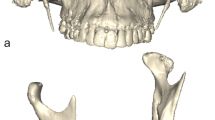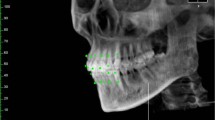Abstract
Purpose To develop an easy-to-use, dentition planning method which is based on three-dimensional (3D) computer planning technology to replace conventional plaster-cast occlusion planning techniques.
Methods The optimal dental occlusion is defined according to the condition of centric occlusion, i.e. after bringing occlusal surfaces of mandibular and opposing maxillary arches into identical 3D position. This identical position of occlusal surfaces represents the common reference frame for the 3D manipulation of all graphical elements. The planning procedure involves the following steps: (1) the optimal occlusal surface is approximated as triangle and localized both on the maxilla and mandible; (2) the original volumetric model is resampled according to the occlusal orientations; (3) the program reads in the models of ideal upper and lower dental arches from files, reshapes those to the patient anatomy and visualizes the local alignment on separate panels for mesiodistal and faciolingual inclinations. The final goal of the proposed method is to combine the requirements of functional and aesthetic designs and create an input for orthodontics, implantology and maxillofacial surgery.
Results In the present study the optimal dental occlusion is created by image resampling after bringing the occlusal surfaces of mandibular and opposing maxillary arches into identical 3D position. This identical position of occlusal surfaces represents the common reference frame for manipulation of all graphical elements.
Conclusions The proposed graphical environment was able to fit the elements of the ideal dentition curve to patient computed tomography under predefined centric occlusion. Rotation and scaling transformations of teeth were possible in the reformatted volumetric views about any of the axes of the teeth’s own reference space.
Similar content being viewed by others
References
Cousley RRJ, Grant E, Kindelan JD (2003) The validity of computerized orthognathic predictions. J Orthod 30:149–154
Harris M, Reynolds IR (1991) Cephalometric analysis. In: Harris M, Reynolds IR (eds) Fundamentals of orthognathic surgery. Saunders, London, pp 38–48
Aharon PA, Eisig S, Cisneros GJ (1997) Surgical prediction reliability: a comparison of two computer software systems. Int J Adult Orthod Orthognath Surg 12:65–78
Kobayashi M et al (2006) Diagnostic system (ManMos) for orthognatic surgery. In: Lemke HU, Vannier MW, Inamura K, Farman AG, Doi K (eds) Int J CARS (Supplement 1 to CARS 2006, Osaka, Japan). Springer, Berlin Heidelberg New York, pp 539–540
Pongrácz F, Bárdosi Z, Szabó L (2004) Dentition planning for image-guided implantology. In: Lemke HU, Vannier MW, Inamura K, Farman AG, Doi K, Reiber HC (eds) Proceedings of 18th international congress and exhibition of CARS. Elsevier ICS 1268, Amsterdam, pp 1168–1173
Pongrácz F, Bárdosi Z (2006) Dentition planning with image-based occlusion analysis. In: Lemke HU, Vannier MW, Inamura K, Farman AG, Doi K (eds) Int J CARS (Supplement 1 to CARS 2006, Osaka, Japan). Springer, Berlin Heidelberg New York, pp 537–538
Pongrácz F, Bárdosi Z (2006) Graphical tools for dentition planning. In: Zeilhofer HF, Lambrecht T, Müller A (eds) Abstract book of 2nd international Bernd–Spiessl symposium. Basel, Switzerland, pp 40–41
Arun KS, Huang TS, Blostein SD (1987) Least square fitting of two 3-D point sets. IEEE Trans Patt Anal Machine Intell (PAMI) 9:698–700
Press WH, Teukolsky SA, Vetterling WT, Flannery BP (1992) Numerical recipes in C. The art of scientific computing. Cambridge University Press, Cambridge
Hassan H et al (2005) A volumetric 3D model of the human jaw. In: Lemke HU, Vannier MW, Inamura K, Farman AG, Doi K (eds) Proceedings of 19th international congress and exhibition of CARS. Elsevier ICS 1281, Amsterdam, pp 1244–1249
Massler M, Schour I (1982) Atlas of the mouth, 2nd edn. American Dental Association, Chicago
Chapuis J et al (2005) A new approach for 3D computer-assisted orthognatic surgery – first clinical case. In: Lemke HU, Vannier MW, Inamura K, Farman AG, Doi K (eds) Proceedings of 19th international congress and exhibition of CARS. Elsevier ICS 1281, Amsterdam, pp 1217–1222
Xia JJ, Gateno J, Teichgraeber J, Rosen A (2001) Methodology of precise skull model creation. In: Niessen WJ, Viergever MA (eds) Proceedings of MICCAI-2001. Springer, Berlin Heidelberg New York, pp 434–440
Pongrácz F, Renner G (2005) Localized volume matching for the detection of relative displacements in CT or MR images. In: Lemke HU, Vannier MW, Inamura K, Farman AG, Doi K (eds) Proceedings of 19th international congress and exhibition of CARS. Elsevier ICS 1281, Amsterdam, pp 56–61
Eggbeer D, Bibb R, Williams R (2005) The computer-aided design and rapid prototyping fabrication of removable partial denture frameworks. Proc Inst Mech Eng 219(3):195–202
Author information
Authors and Affiliations
Corresponding author
Rights and permissions
About this article
Cite this article
Pongrácz, F., Bárdosi, Z. Dentition planning with image-based occlusion analysis. Int J CARS 1, 149–156 (2006). https://doi.org/10.1007/s11548-006-0052-6
Published:
Issue Date:
DOI: https://doi.org/10.1007/s11548-006-0052-6




